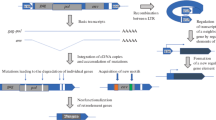Abstract
It has been proposed that the most extensively studied mammalian retrotransposons replicate by some form of a master template model. This conclusion has been drawn largely from DNA sequence analysis and is based on phylogenetic tree topology, the presence and ordering of shared variants, the degree of divergence between elements within a subfamily, and the shape of the distribution of pairwise differences between elements. To investigate how robust these parameters are as predictors of the model of transposition, computer simulations of the two most extreme transposition models, the Random Template Model and the Strict Master Model, were carried out. A prototype of a computer simulator for studying retrotransposition is presented. The simulator is a versatile digital workbench that maintains DNA sequence data and allows manipulation of a range of factors including reverse transcriptase and in situ mutation rates, transposition template, and transposition rate. All parameters previously used as predictors of the model of transposition were markedly different for the two extreme models when evaluated using large sample sizes of sequences from experiments simulating up to 15 million years of evolution.
Similar content being viewed by others
References
Adey NB, Schichman SA, Graham DK, Peterson SN, Edgell MH, Hutchison III CA (1994) Rodent Ll evolution has been driven by a single dominant lineage that has repeatedly acquired new transcriptional regulatory sequences. Mol Biol Evol 11:778–789
Berg DE, Howe MH, eds (1989) Mobile DNA. American Society of Micro, Washington, DC, 972
Britten RJ, Baron WF, Stout DB, Davidson EH (1988) Sources and evolution of human Alu repeated sequences. Proc Nat Acad Sci USA 85:4770–4774
Brosius J (1991) Retroposons—seeds of evolution. Science 251:753
Casavant NC, Hardies SC (1994) The dynamics of murine LINE-1 subfamily amplification. J Mol Biol 241:390–397
Deininger PL (1989) SINEs: short interspersed repeated DNA elements in higher eucaryotes. In: Berg DE, Howe MH (eds) Mobile DNA. American Society of Micro, Washington, DC, pp 619–636
Deininger PL, Batzer MA (1993) Evolution of retroposons. Evol Biol 27:157–196
Deininger PL, Batzer MA, Hutchison III CA, Edgell MH (1992) Master genes in mammalian repetitive DNA amplification. Trends Genet 8:307–311
Doolittle WF, Sapienza C (1980) Selfish genes, the phenotype paradigm and genome evolution. Nature 284:601–603
Furano AV, Hayward BE, Chevret P, Catzeflis F, Usdin K (1994) Amplification of the ancient murine Lx family of long interspersed repeated DNA occurred during the murine radiation. J Mol Evol 38:18–27
Hutchison III CA, Hardies SC, Loeb DD, Shehee WR, Edgell MH (1989) LINES and related retroposons: long interspersed repeated sequences in the eucaryoric genome. In: Berg DE, Howe MH (eds) Mobile DNA. American Society of Micro, Washington, DC, pp 593–617
Kass DH, Berger FG, Dawson WD (1992) The evolution of coexisting highly divergent LINE-1 subfamilies within the rodent genus Peromyscus. J Mol Evol 35:472–485
Lee RN, Jaskula JC, Van Den Bussche RA, Baker RJ, Wichman HA (1996) The retrotransposon mys was active during evolution of the Peromyscus leucopus-maniculatus complex. J Mol Evol 42:44–51
Martin SL (1991) Ribonucleoprotein particles with LINE-1 RNA in mouse embryonal carcinoma cells. Mol Cell Biol 11:4804–4807.
Martin SL, Voliva CF, Hardies SC, Edgell MH, Hutchison III CA (1985) Tempo and mode of concerted evolution in the L1 repeat family in mice. Mol Biol Evol 2:127–140
Maddison WP, Maddison DR (1992) MacClade: analysis of phylogeny and character evolution, version 3.0. Sinauer Associates, Sunderland, MA
McDonald JF (1990) Macroevolution and retroviral elements. Bioscience 40:183–191
Orgel LE, Crick FHC (1980) Selfish DNA: the ultimate parasite. Nature 284:604–607
Pascale E, Liu C, Valle E, Usdin K, Furano AV (1993) The evolution of long interspersed repeated DNA (LI, LINE 1) as revealed by analysis of an ancient rodent L1 DNA family. J Mol Evol 36:9–20
Rikke BA, Garvin LD, Hardies SC (1991) Systematic identification of LINE-1 repetitive DNA sequence differences having species specificity between Mus spretus and Mus domesticus. J Mol Biol 219: 635–643
Shen MR, Batzer MA, Deininger PL (1991) Evolution of the master Alu gene(s). J Mol Evol 33:311–320
Singer MF (1982) SINEs and LINES: highly repeated short and long interspersed sequences in mammalian genomms. Cell 28:433–434
Varmus H, Brown P (1989) Retroviruses. In: Berg DE, Howe MH (eds) Mobile DNA. American Society of Micro, Washington, DC, pp 53–108
Wichman HA, Potter SS, Pine DS (1985) Mys, a family of mammalian transposable elements isolated by phylogenetic screening. Nature 317:77–81
Willard C, Nguyen T, Schmid CW (1987) Existence of at least three distinct Alu subfamilies. J Mol Evol 26:180–186
Author information
Authors and Affiliations
Additional information
Correspondence to: H.A. Wichman
Rights and permissions
About this article
Cite this article
Clough, J.E., Foster, J.A., Barnett, M. et al. Computer simulation of transposable element evolution: Random template and strict master models. J Mol Evol 42, 52–58 (1996). https://doi.org/10.1007/BF00163211
Received:
Accepted:
Issue Date:
DOI: https://doi.org/10.1007/BF00163211




